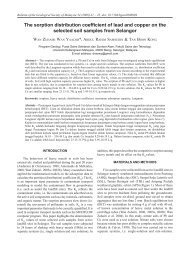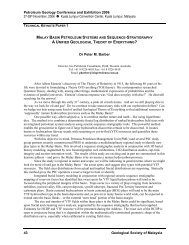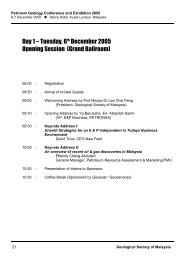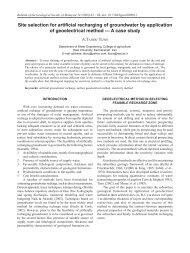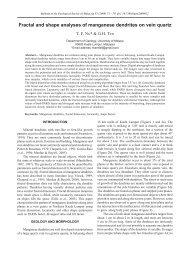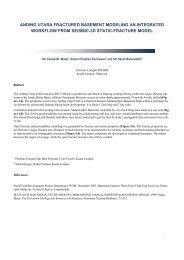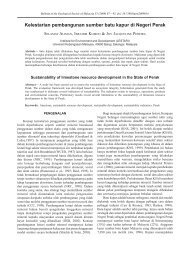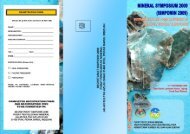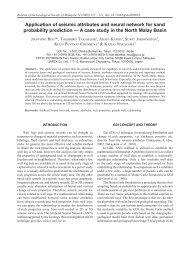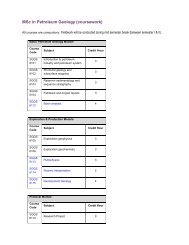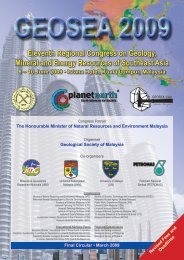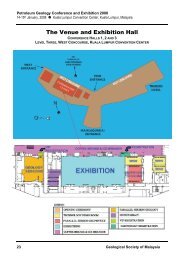warta geologi warta geologi - Department Of Geology - Universiti ...
warta geologi warta geologi - Department Of Geology - Universiti ...
warta geologi warta geologi - Department Of Geology - Universiti ...
You also want an ePaper? Increase the reach of your titles
YUMPU automatically turns print PDFs into web optimized ePapers that Google loves.
PERTEMUAN PERSATUAN (Meetings of the Society)matrix (squashed mud clasts). Evidence of diagenesis is in theform of thin quartz overgrowths and traces of siderite, pyrite,and pore-lining illite. Dissolution of unstable grains (feldsparsand unstable lithics) is also observed which creates a secondarypore-system that enhances the total porosity.The reservoir quality of the sandstones changes with thefacies and environments. The lowstand fluvial sands tend tobe coarser grained, but more poorly sorted than the deltaicsands. The deltaic sands are finer grained, but tend to be bettersorted than the fluvial sands, likely due to the wave-activitymodifying the sands. Although the lowstand sands have relativelygood reservoir quality, the shelf sediments are dominated bythe transgressive and highstand deposits making them moretargetable than the lowstand deposits contained within incisedvalleysfeeding deepwater systems.ReferencesBalaguru, A., 2006. Orogeny in Action: Tectonic Evolution andStratigraphy of Sabah, Seismic and Outcrop Evidence,Petroleum Geoscience Conference and Exhibition (PGCE)Abstract.Pettijohn, F.J., Potter, P.E., and Siever, R., 1987. Sand andSandstone, 2nd Edition, Springer-Verlag, New York, 572pp.Wilson, R.A.M. and Wong, N.P.Y., 1964. The <strong>Geology</strong> andMineral Resources of the Labuan and Padas Valley Area,Sabah, Malaysia, Memoir 17, Geological Survey BorneoRegion, Malaysia, 150pp.Paper P40An Integrated Approach Towards Delineating Hydrocarbon Prospectivity inUntested Fault Blocks Within a Brown Field. A Case Study in B Field, <strong>Of</strong>fshoreSarawak, MalaysiaA. Azami* (Petronas Carigali Sdn Bhd), A. Hashim (Petronas Carigali Sdn Bhd),N. Alias (PETRONAS Petroleum Management Unit), N. Ujal (Petronas Carigali Sdn Bhd),M. Bhattacharya (Petronas Carigali Sdn Bhd), A. Roy (Petronas Carigali Sdn Bhd),S. Pamungkas (Petronas Carigali Sdn Bhd) & T.. Aldha (Petronas Carigali Sdn Bhd)B Field is located approximately 80 km from Bintuluin water depth of about 90 feet, Balingian Province, offshoreSarawak, Malaysia. In was discovered in 1976, with first oilachieved in 1984. Since then, more than 70 wells have beendrilled, with production coming from three main accumulations:B North, West, and Northwest. A forth accumulation, B Eastwas recently discovered in 2006. Structurally, B Field is heavilyfaulted, with the southwest to northeast and associated antitheticfaults giving rise to numerous compartmentalizing fault blocksamong the adulating anticlines and synclines. Furthermore,channelized sand bodies add another level of complexity towardsunderstanding the hydrocarbon distribution in B. The reservoirsof interest are on Late Oligocene to Early Miocene in age andoccur at an average depth between three to five thousand feetsubsea. Depending on the stratigraphic succession, these CycleII reservoirs are interpreted to have been deposited in a LowerCoastal Plain environment, with channel morphologies rangingfrom braided streams to meandering and distributary channels.In order to mitigate the uncertainty associated with reservoirpresence (sand distribution) and hydrocarbon occurrencesin untested prospective fault blocks, a holistic integratedapproach was adopted. By rationalizing all available <strong>geologi</strong>cal,geophysical and production data, an attempt was made to producea cohesive and consistent <strong>geologi</strong>cal conceptual model able topredict hydrocarbon presence beyond the proven areas. Theworkflow began by understanding the depositional environmentof the field as observed from well logs and core data. Possiblechannel widths were established by comparing the observed datawith analogs from available literature. A general provenancedirection was also known from the understanding of regionalgeology and dipmeter data. Reservoir morphology was furtherdelineated by using seismic attributes such as RMS of amplitude238and sum of negative amplitudes, applied on the angle stackseismic data. Observed anomalies between the near and farstack seismic data allowed us carve-out prospective areas awayfrom know hydrocarbon pools of B Field. These anomalieswere further validated by comparing with the well logs andpetrophysical data from nearby producing areas. Furthermore,the area and zones of interest were subjected to an AVO studyin order to assess the hydrocarbon occurrence probability. Thevolumes were calculated and risked accordingly in order toaccount for the remaining uncertainties. The identified prospectshave been consistently supported by the available data andstudies, and this has led to the finalizing of a drillable locationabout five kilometers Northwest of nearest platform. The targetis situated on an isolate horst block of a plunging anticlinewith the northerly plunging axis. B field has yet to prove theviability of a stratigraphic and structural combination trap. Asound integrated approach as adopted here has a potential forprobing hydrocarbon reserves in this new plays types.ConclusionsA sound integrated approach as adopted here has a potentialfor probing hydrocarbon reserves in this new plays types.AcknowledgementsBayan team members, PEG management, PEB managementand Specialized Study group (PEG).ReferencesPETRONAS, 1999. The Petroleum <strong>Geology</strong> and Resource ofMalaysia. Petroliam National Berhad, Kuala Lumpur,Malaysia.Warta Geologi, Vol. 38, No. 2, April – June 2012



